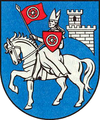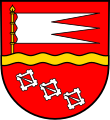Flag (heraldry)
The heraldic flag is a special feature of the coat of arms . Many flags and flags have proper names that are typical of the coat of arms. They are shown in the coat of arms or in the upper coat of arms , but also held by shield holders . Often riders wear one of these emblems. But there are also flags of this type heraldic animals to hold. The Montfort church flag , which is common in heraldry , is also used frequently . Diversity has found its way here. If there are heraldic figures on the flag, they will by default face the flagpole. Lance shafts and flagpoles are only mentioned in the blazon if they are not golden (standard).
The flags described here are:
- the flag ,
- the banner with a swivel (shown diagonally on the right or left in the coat of arms),
- the storm flag ,
- the servant flag ,
- the wind vane ,
- the pennant and
- two kinds of the standard .
They differ from the real flags and banners, somewhat for heraldic reasons, because they are very close. With the blazon (description of the coat of arms) it is helpful to recognize these differences.
The little flag is a flag that is slanted on the flagpole with two to three incisions in the flag. The tip of the stick is often pointed, but also has other designs (cross or lily ends).
The banner with a swivel is a flag standing vertically on the flagpole, the flag of which has an extension in the upper third. This band (swivel) is shown so long that it can be placed in the coat of arms to below the flag. The flag is used waving to the right or left in the coat of arms.
The storm flag is similar to this flag . It has the handle below. But this is only shown fluttering.
The pennant is a triangular flag on the flagpole. In the case of the little wind vane, the square flag widened from about the middle of the cloth into a triangle that tapers at the top.
The standard can be displayed like a flag on the flagpole or like a church flag on the crossbar with flagpole.
The servant's flag is a narrow flag with at least four incisions on the long outer edge. This edge of the cloth can be sewn ornate.
Common figures can be shown on all flags . Often the flag is attached to a lance. Then it's a flagged lance.
Many flags also have very special names that have been handed down from the early days and can be found in descriptions of coats of arms. In addition to Latin names such as Gonfanon, Bandon, Flammular and the usage, as well as St. John's flag, crusader flag and tournament flag enrich the naming. Vexillum (Roman) and the Lambarum of Constantine are also examples.
gallery
Little flag (servant flag or racing flag )
literature
- ^ Milan boys : Heraldry. Illustrations by Julie Bubnová. Edited edition. Albatros, Prague 1987.






